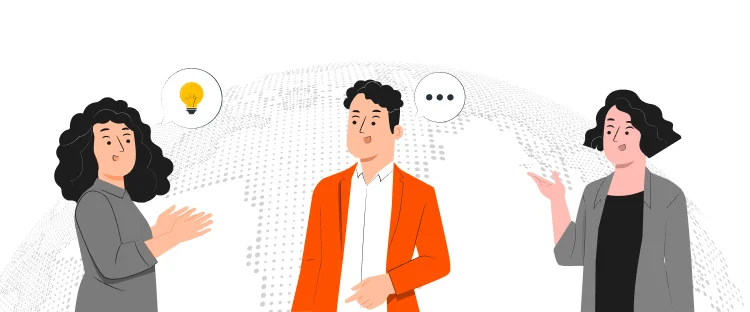By: Abdurahman Virk Posted on Fri, 07-06-2024

Brazil is one of the most culturally and linguistically diverse countries in Latin America. To get the gist, just like India, the Brazilian culture, ethnicities, and landscape are far more dynamic than usually anticipated. Want to know what languages are spoken in Brazil? Well, the population of Brazil is over 200 million people, and as a result of historical events, colonization, and mass migration, the linguistic arena of Brazil includes more than 200 languages, including Portuguese and 11 other immigrant or foreign languages, and more than 180 indigenous languages.
Moreover, in modern-day Brazil, there are only 20,000 to 40,000 native speakers of these indigenous languages left. Although 97.9% of the Brazilian population speaks Portuguese, that makes Brazil the most Portuguese-speaking country in the world. Moreover, Brazilian culture is rich with colonial footprints, carnival festivities, martial arts, and religious inclinations dominated by 64.6% Roman Catholics.
Portuguese is the official language of 97.9% of Brazil but there are over 180 indigenous languages and influences from immigrant communities like Germans, Italians, Japanese, and Africans.
The linguistic landscape reflects Brazil's history. Portuguese arrived with colonization, while slavery brought African languages. Immigration waves from Europe and Asia further diversified the languages.
Even Portuguese has regional variations. Southern dialects show European influence, while Northeastern dialects have African and indigenous influences.
Pronunciation and vocabulary are key differences between Brazilian and European Portuguese. Brazilians tend to use more open vowels and have a softer "r" sound. Words for everyday things can also differ.
The variety of languages creates communication barriers, but also contributes to Brazil's cultural richness. Translation services play a crucial role in bridging the gaps.
Portuguese is the official language of Brazil. Moreover, it is important to note that although the Portuguese spoken in Brazil and Portugal (European Portuguese) are mutually intelligible, there are differences in grammar and syntax. Brazilian Portuguese translation services are proved to be very helpful for comunication in Brazil.
.After Portuguese, German is the second most spoken language in Brazil. German speakers account for 1.9% of the Brazilian population. Moreover, the ethnic diversity of Brazil is also breathtaking, e.g. Brazil hosts one of the largest Japanese populations outside of Japan. Thus, Japanese is also one of the Brizilian languages. The same is the case with Africans, since Brazil used to be the home of the largest African slave market, it is also home to a large African population.
Additionally, Spanish is the second most learned and spoken foreign language in Brazil after English. If you are familiar with Spanish, your journey to explore Brazil gets easy. Moreover, Portuguese and Spanish share Iberian origins and thus resulted in the gradual formation of Spanish to Brazilian Portuguese versions. Yet for contemporary Spanish speakers, the learning experience of Brazilian Portuguese is a hectic task. For a moment, if we can set aside the dialectical diversities of the Portuguese language, learning Brazilian Portuguese is still challenging for Spanish speakers. These differences go beyond vocabulary and include pronunciation, idiomatic expressions, syntax, and cultural idioms.This linguistic diversity often creates some communication barriers. That is why there is a spike in the demand for translation services.
In this guide to Brazilian languages and culture, we will explore the linguistic tapestry of Brazil and uncover the social, historical, and cultural elements of Brazilian society.
Brazil is always a welcoming country for all the foreign cultures and languages. That is why in today’s Brazil, the amazing blend of African, Japanese, and Spanish eateries is like nowhere on earth. Brazilian people welcomed those immigrants with open arms and accepted them as their own.
Want to know what language do they speak in Brazil? Around the year 1500, when Portuguese arrived in South America, historians say that over 1200 languages were spoken in the area. Interestingly, most of these languages are indigenous to Brazil. However, under different linguistic regulations and restrictions, over the centuries, the linguistic riches of the area became scarce and currently reduced to 180 indigenous languages. One example is the policies of 1959, according to which the official and unofficial use of the original languages, “línguas gerais” (linguas francas, used as the means of communication between the natives and Portuguese Colonists) was strictly prohibited.
Another important era of linguistic evolution was noticed between the slave trade of the 15th and 19th centuries. Thousands of natives of 200 to 300 indigenous languages were estimated to have arrived in Brazil during that period. However, the colonist mindset and the traditions of slavery resisted the community building of these communities and resulted in the dispersed accommodation and mixed immigrant race with Brazilians. But soon after Brazil prohibited the centuries-old tradition of slavery in 1888, these hundreds of languages became the specs in the linguistic ocean of Brazil. The features of the African language in Portuguese and even in the grammatical structure of some of these languages can be witnessed in modern-day Brazil.
When it comes to the modern landscape of Brazilian language diversity, the period between 1880 and 1960 is very crucial. During this period, Italian, Portuguese, Japanese, German, and others not only arrived, but settled in Brazil. The southern part of Brazil is the true example of this linguistic rift where Portuguese is spoken by comparatively few. Furthermore, amid these factors, we cannot ignore the important geographical location of Brazil. During the wake of the 21st century, there have been many major historic events that resulted in mass migration from different surrounding and even distant countries. For example, South Koreans, Spanish, Japanese, Chinese, Parahuayams, Bolivians, and French are among those immigrants.
Moreover, many countries forcefully ostracized their people. Haiti, Venezuela, Syria, and the Democratic Republic of Congo are a few of these cities. These people arrived in Brazil with their beautiful culturally rich traditions and contributed to the linguistic and cultural diversity of Brazil. An important factor is that Brazil is a neighbor to all the South American countries except a few. In modern-day Brazil, these communities are a part of the growth magnet of Brazil. But when it comes to business, legal, or professional communications, the language barrier still exists. To overcome this barrier and streamline communications, the role of a professional translation company is pivotal.
When it comes to mass, there comes the rise of crimes, and other illegal activities. Despite all these factors, Brazilian people absorbed every culture without complaining, additionally, the immigrants also put everything on the table they could. In terms of skills, labor, languages, etc. Resultantly, over the next century. Brazil has emerged as the beacon of innovation and diversity. For example, take the example of the UFC, the multi-billion industry of martial arts, it all started with the migration of Japanese martial artist, Mitsuyo Maeda, who migrated to Brazil and taught his skills to the Gracie family, they upgraded the Grappling martial art and emerged as one of the most advanced grappling martial art (Jiu Jitsu) masters. Later, the descendants of Gracie founded UFC and these two martial arts are now considered not only one of the most practiced but the most efficient martial arts.
The canvas of Brazilian linguistic tapestry is filled with the colors of regional immigrant languages and cultural preferences. Amid this spectrum of languages, the difference in the dialects of regional Portuguese is important. It will help us draw lines between the interwoven threads of Portuguese heritage across Brazil. Below are the dialectical differences in Brazilian Portuguese.

Since Portuguese is one of the most spoken languages of Brazil, people often confuse it with the Portuguese of Portugal which is also known as European Portuguese. Let’s find out the differences between the European and Brazilian Portuguese. The key difference between the region-specific Portuguese language is pronunciation. To be more specific, Brazilians put more emphasis on the vowels whereas Europeans like to pronounce the vowels with their mouth almost closed. Just like the differences between American English and British English, there are different words for the same things in Brazilian and European Portuguese.

Examples of the difference of European Portuguese (Portugal) and Brazilian Portuguese.

Despite the differences in pronunciation, Portuguese words are similar to English in spelling and meaning. When it comes to foreign languages, English is the most learned and spoken foreign language in modern-day Brazil. Interestingly, the colonial effects of English speakers left their mark in almost all the colonized countries.

The linguistic influence starts from the root words. This is an example of the African and Indigenous influence on the Brazilian Portuguese:

Brazil is one of the most populated countries in the world with 5,570 cities including industrial areas, thick forests of the Amazon, and urban areas filled with infrastructures specific to its history, culture, and architectural remains of colonists. In this exclusive chart, explore the linguistic diversity of Brazilian Portuguese.

This guide to the Brazilian Portuguese languages and culture is aimed at spreading awareness about the rich cultural and linguistic heritage of Brazil. From Portuguese colonizers to modern-day Brazil, linguistic evolution has contributed to the industrial and socio-cultural progress of the 21st century. Each community has its distinctive identity, unique linguistic traits, and cultural affiliations. Over the centuries, Brazilian people stood tall in accommodating, welcoming, and living their lives shoulder to shoulder with all the immigrant nations and indigenous people.

Colorado is said to be one of the best places to do business because the business environment is very friendly
Read More
The global marketplace has become an attractive place for brands and businesses, where they strive to create a presence of
Read More
CAD, or computer-aided design and drafting (CADD), is the use of computer technology for design and design documentation. CAD software
Read More
Many global companies, foreign governments and Iranian are hoping to see an increase in investment in Iran after declaring the
Read More
Artificial intelligence has taken a big space in almost every industry. There is also a widespread acceptance that AI is
Read More
Persuasion is all about manipulating other people behavior. At first it might sound immoral but it doesn’t have to be.
Read More
Now days everyone is searching for good ideas for their company they wanted to be more creative, they wanted to
Read More
Technology has now much diverse roots in this age of development. Now it is not wrong to say, that you
Read More
Localization is the practice of altering the functional properties of a product and also its characteristics. This is easily done
Read More


Document Translation
Professional document translation by native expertsApp Localization
Get more downloads by adapting your app for different target marketsVideo Translation
Multilingual translation and subtitling servicesWebsite Localization
Adapt your website into multiple contexts for global reachSoftware Localization
Adapt your software for global usersGame Localization
Reach new players with localized gameplayMTPE
Refine AI translations for natural fluencyBusiness Translation
Professional translation for business documents and websitesDTP & File Conversion
Professional DTP and File conversion, supporting multiple file formatsProofreading
Perfect your content with expert review© Copyright 2025 MarsTranslation